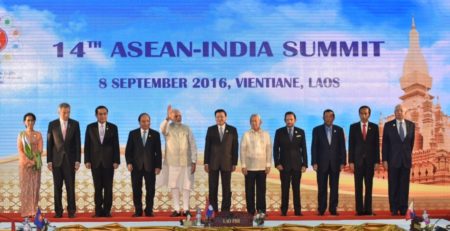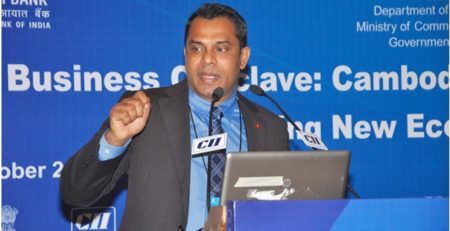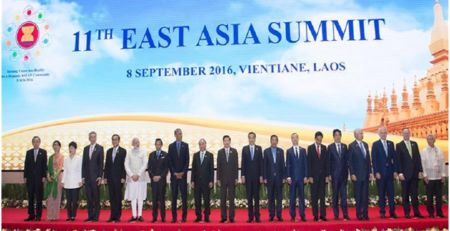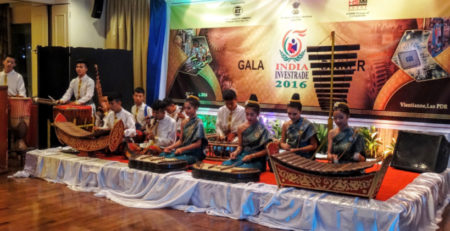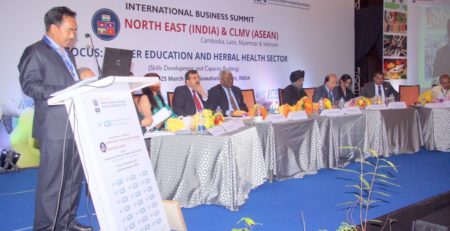The Growing Business Ties between North East India and ASEAN Countries
North East India due to its critical geographic location is considered to be the bridge between two sub-regions of Asia-South Asia and Southeast Asia. The North East consists of eight states, shares an international border of more than 4,500 km with countries like Bangladesh, Bhutan, China, Myanmar and Nepal while it is connected to the rest of India through a 22 km narrow link – Siliguri corridor.
This shows that the region has great advantage and potential to transform. India and the countries that share borders with the North East constitute a market of about 2.81 billion people which is roughly 40% of the world population. With 98% of North East India’s periphery lying in between the Asia-South Asia and Southeast Asia, the region has the potential to transform into the principal gateway to international trade, increasing the scope of trade between ASEAN countries.
Of these five bordering countries Myanmar is the only ASEAN nation to share a land boundary with India showing both the regions’ critical importance in India’s foreign policy.
The Association of Southeast Asian Nations or ASEAN consists of ten member countries viz. Indonesia, Malaysia, Philippines, Singapore, Thailand, Brunei Darussalam, Vietnam, Lao PDR, Myanmar and Cambodia. The association was set-up to accelerate economic, social, cultural growth and facilitate education, agriculture and industries among the member countries.
The North-Eastern region of India lies in such a strategic location that it can act as a key player in ‘Act East Policy’ of India by partnering with ASEAN which will be vital for the economic development of the Northeastern region. Act East Policy holds a prime place in India’s new proactive policy, as it is meant to boost commerce, connectivity and cultural ties with ASEAN. The trade between India and ASEAN is mostly manufacturing products and is restrictive towards the agricultural products. Therefore there is a need to focus on other aspects such as education, culture exchange program and tourism. In order to take the advantages of the growing trade alliances, effort should be on improving inter-state connectivity and market integration.
For developing better business ties among ASEAN and North East, priority should be given to upgrade the economic corridors. Road is an important mode of travel in this region due to its hilly terrain. In the last few years, constructing the Stilwell Route/Ledo Road has been seen as a medium to extend trade linkages with Myanmar and China.
The trade groups in India, especially in the Northeastern region have shown keen interest in reopening this strategic roadway because of its enormous economic potential. Besides airways and railways can be good ways to connect to the neighbouring countries of the region.
The limited industrialization that the region has so far seen has been centred around a few resource-based industries such as petroleum and natural gas, tea, coal, jute, forest products, some mineral based industries and some micro household industries such as handloom and handicrafts. The organised sector includes tea, petroleum, paper, cement, plywood, coal, jute, sugar and a few others while the unorganized sector represents a majority of enterprises in the region and includes the handloom and handicrafts, small food processing units, etc. By far the most important industries in the region are the tea and petroleum industries. The flow of trade in the NE region has therefore been witnessed around these commodities. With rich mineral bases, the region’s exports have primarily been raw materials such as coal, limestone, bamboo, fruits and vegetables while it has been importing mostly finished products from neighbouring countries.
Southeast Asia has rich and diverse set of natural and tangible and intangible cultural tourism resources located in both rural and urban areas. The region’s 11 natural and 17 cultural heritage sites inscribed in the UNESCO World Heritage List highlight and reflect its unique heritage. Enmeshed with its natural heritage is a rich and diverse endemic ethnic culture with overlays of Arab, Chinese, Indian, and European influences. Buddhist, Hindu, Muslim and Christian religious traditions, and vernacular architecture, music, literature, and indigenous knowledge enrich the region and add to the appeal of its outstanding natural heritage, its rural landscapes, and its vibrant urban centres.
Southeast Asia holds great prospects for the Northeast India as a market and vice versa within the ambits of the Act East Policy (AEP) and the Vision 2020 document, which deals with the international facet of tourism promotion. Also, developing backward tourism connectivity with other parts of India is as important an element of strides in tourism as developing links with Southeast Asian countries, which answers to the national aspect. For this reason, it is important to recognize tourism as a promising revenue generator.
India has a major partnership with her neighbouring ASEAN countries in trade and investment.

Myanmar, a member of ASEAN, has become a major link between India and ASEAN countries. And North East, particularly Manipur ought to become the center of thriving and integrated economic space linking two dynamic regions with a network of highways, railways, pipeline, and transmission lines crisscrossing the region. Development of the North East is thus integral to India’s policy on Myanmar. North East is a corridor and a transit route to South East Asia. Infrastructure building tops the priority.
The Indian government is giving a renewed push to road connectivity with Southeast Asia. The India-Myanmar-Thailand (IMT) highway starts from Moreh in Manipur on the India-Myanmar border and runs via Tamu (Myanmar) to Mae-Sot in Thailand. The project will require about 78 km of new roads and the upgrading of existing 400 km of roads. In Phase 1, India has the responsibility of building 78 km of missing links, upgrading 58 km of existing roads, and possibly improving a further 132 km. Thailand has taken on the responsibility of upgrading a total of 192 km in this phase and another 100 km under Phase 2. The idea of the trilateral highway was conceived at the Trilateral Ministerial Meeting on Transport Linkages in Yangon in April 2002. The 1,360-km IMT highway was initially scheduled to be completed by 2015. According to an official from India’s MEA, the completion of the project is now expected by 2020.
The North East has the potential to become a manufacturing hub and for this, the region needs to be connected more densely with the ASEAN and beyond. This will require building infrastructure – roads, railway lines, river transport, airports, tourism infrastructure, border check-posts, educational, and health infrastructure, etc. India’s North-eastern region is one of the pockets that do not seem to have profited in the changed economic environment. With its geographical remoteness, inherent deficiency in infrastructure and the bad publicity for recurrent ethnic strife and militant activities, the region obviously could not become an attractive destination for private capital investment. But in the period in which closer cross-border economic ties are being forged in many parts of the world, border trade has come to be looked upon with a lot of expectations in this region as a means for breaking free from the shackles of geographical isolation. All but two per cent of the boundary of the region happens to be international border which is shared with Bhutan, China, Myanmar and Bangladesh. While trade with Bangladesh and Bhutan has assumed importance in the wake of attempts to forge greater South Asian regional co-operation, trade with Myanmar has acquired added significance in the context of India’s proclaimed ‘Act East Policy’ because of Myanmar’s geographical proximity to the prosperous economies of South-East Asia and China. In other words, trade across Indo-Myanmar border is perceived as not merely a two-country affair but a via-media for closer economic ties even with counties to the east and south east of Myanmar. India’s north eastern states and Myanmar should be the main target markets of many products manufactured in the Special Economic Zones (SEZ) to once again make India’s north eastern states and northern Myanmar a natural economic zone, which they historically were, providing a sustainable economic life line to the north eastern states. But this would require enormous fast-paced infrastructure development on the Indian side of the border with Myanmar.
India’s North East is among the most endowed states in terms of the natural resources, including several critical minerals that it possesses, and has substantial potential for generating one of the preferred low-carbon forms of energy, viz. hydro-electricity. Besides, it sits at the door-step of the East Asia, the region with which India is increasing its economic ties.
The region is unique in terms of the opportunities it offers. While it is an industrial desert where almost all immediate consumables are imported from outside the region, the Northeast is the focal point of trade within a vast area. About 96 per cent of this region’s borders form India’s international boundaries. So the region enjoys very special advantages over other parts of India in trade in view of India’s Act East Policy in general and India’s economic engagement with her eastern neighbours through India-ASEAN Free Trade Agreement (FTA) and other bilateral FTAs in particular. The official trade, mostly under barter arrangements, is modest and dwindling. There is a need to plug into the growing trade with ASEAN countries particularly in items like bamboo and wood products, ores and rubber products, horticulture, etc. At the same time, it is imperative to integrate IT facilities in promoting infrastructure for trade with the ASEAN countries. There is urgent need to promote interaction with neighbouring countries for enhancement of cross-border trade and investment.
The progress of the Indo Myanmar border trade is slow and takes place in goods domestically produced in India, informal trade from Myanmar to India through Moreh is done in both domestically produced in Myanmar and goods originated in third countries such as: China, Korea, Japan, etc. Various forms of restrictions in the border trade, law and order situations and multiple check-posts on the national highway are impeding the progress of border trade. It may also be worth noting that border trade between India and Myanmar has created a large number of employment opportunities among the economically active people living on both sides of the border as well as in different parts of Manipur.
In a bid to increase the trade volume between India and South East Asian countries, the Ministry of DoNER and Government of Manipur has come up with proposal of setting-up ‘Border Haats’ (border markets for cross border exchange of goods.) viz. Kongkan Thana in Ukhrul district of Manipur and Aungci of Myanmar; New Somtal of Chandel in India and Thenjen of Myanmar and Behiang district of India and Khenman of Myanmar.
To deepen the relations between India and ASEAN countries, the Ministry of External Affairs, India with cooperation from ASEAN nations took the initiative of organizing the India-ASEAN Car Rally. The proposal for the rally was first mooted by former Prime Minister Atal Bihari Vajpayee at the ASEAN-India Summit in Bali, Indonesia to bring India closer to the South-East Asian group. The rally organized from time-to-time, aims to create unprecedented people-to-people contact among these nations, demonstrate India-ASEAN proximity and road connectivity and promotes infrastructure development, especially to facilitate road transport, also enhance trade, investment, tourism and people-to-people links.
The 1st edition of the India-ASEAN Car Rally took place from 23 November– 06 December 2004 and was held in 8 countries covering over 8000 km and included 240 participants with 60 vehicles. The rally was flagged off by Hon’ble Prime Minister Dr. Manmohan Singh from Guwahati on 22 November 2004 and a ceremonial flag-off took place at Vientiane, LAO PDR on 30 November 2004 by Dr. Manmohan Singh and the Heads of State of all ASEAN nations during the 3rd ASEAN-India Summit. The last India, Myanmar and Thailand Friendship Motor Car Rally, was held in November of 2016.
India-ASEAN trade is growing at an average annual rate of 19% and the current trade volume is around US$75 billion. This is a very good indicative of the potential trade volume that North East can alone achieve with ASEAN if proper trading channels are streamlined.
In this 25th anniversary year of ASEAN-India relations, if we can diligently follow the ACT EAST POLICY there is a tremendous economic potential that can be unearthed in the next 10 years. The North East has immense potential to grow and the ties between the ASEAN countries can be beneficial if proper support and border trade is facilitated.









